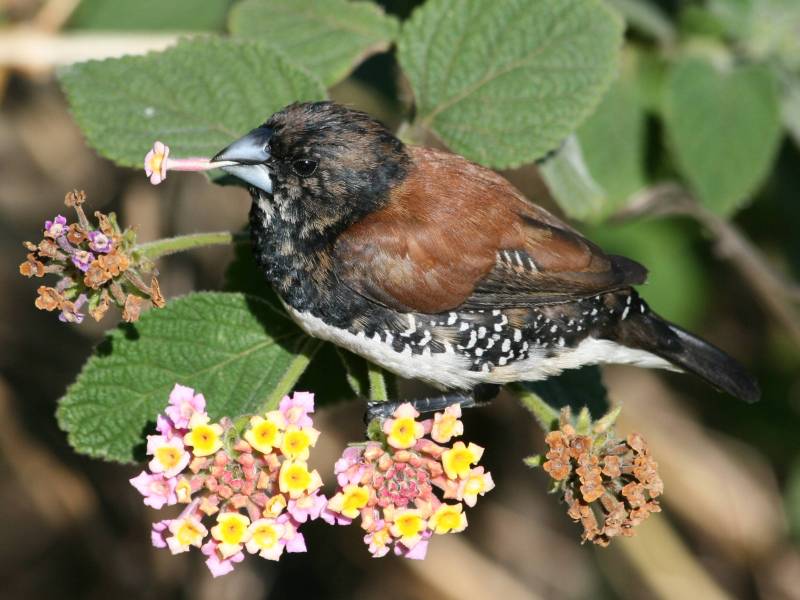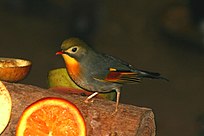Natural History
Known by a variety of common names, the nuns, mannikins and munias are among the most popularly-kept finches. Thirty five to fifty species (their taxonomy is in flux) of these little seed-eaters range throughout Africa, Asia and Australia, often forming huge flocks outside of the breeding season. Their behavior within these flocks is highly synchronized, with members responding as one to visual and vocal cues.
The family of finches to which these birds belong, Estrildidae, is known for its brilliantly-colored members, but many munias are somberly clad in rust, fawn, white and various shades of brown. This does not at all detract from their appearance, as the subtle blending of one color into another creates quite pleasing effects. These muted tones are particularly beautiful when viewed among more brightly-colored finches in mixed-species aviaries.
Most rely heavily upon grass seeds for food, but they also take insects and green shoots, especially during the breeding season. The small size and abundance of the munias renders them important food items for a variety of snakes, lizards, small mammals and birds of prey. Field research on several African species has revealed that 70-80% of the eggs and a large percentage of the hatchlings are taken by predators.
Captive Care
Most species fare well in standard finch cages, although some rarely breed unless held in spacious outdoor aviaries, and are amenable to normal room temperatures. Breeding in many is timed to the arrival of seasonal rains…in captivity the provision of a humidifier or frequent showers may stimulate reproduction.
Most munias bathe daily, and the nails of all grow extremely quickly. Nail overgrowth is less of a problem for birds kept in outdoor aviaries with gravel or stone floors, but those living in cages must be carefully monitored.
Diet
A quality finch seed should form the bulk of the diet. Sprouting grass is usually readily accepted, and small amounts of carrot, broccoli and spinach should be provided on occasion.
Small crickets, mealworms, waxworms and wild caught insects (consider using a ZooMed Bug Napper Insect Trap) are all relished, and are essential for bringing munias into breeding condition and for rearing the chicks. Small canned insects, such as Exo Terra Silkworms, and ZooMed Anole Food (dried insects) are also worth trying. Gravel, cuttlebone and a bird bath should always be available.
Black-Headed Nun, Lonchura atricapilla
A very popular finch, the 4.5 inch black-headed nun is actually not very easy to breed. The sexes are difficult to distinguish, and pairs seem to require a great deal of room and the provision of fresh grasses as nesting material.
Clad in chestnut, and with a black head and breast, this bird possesses a quiet beauty and a fairly calm personality. It is native to southern India but ranges throughout the subcontinent, and is most often found near swamps and forested waterways.
The Black and White Munia, or Fernando Po, Lonchura bicolor
 Barely reaching 3.8 inches in length, this Southeast Asian native is the smallest of the genus, and indeed of all Estrildid finches. Its black feathers are highlighted with a glossy green, while the lower breast and under-parts are white. The Fernando Po is not very common in the trade, but well worth seeking. Its tiny size and active, inquisitive nature render it a charming pet.
Barely reaching 3.8 inches in length, this Southeast Asian native is the smallest of the genus, and indeed of all Estrildid finches. Its black feathers are highlighted with a glossy green, while the lower breast and under-parts are white. The Fernando Po is not very common in the trade, but well worth seeking. Its tiny size and active, inquisitive nature render it a charming pet.
A number of subspecies range throughout much of Africa, usually in association with forests or thick secondary growth.
The Bengalese or Society Finch, L. domestica (L. striata var. domesticus)
 Hobbyists are sometimes surprised to learn that this pet trade staple is not to be found in the wild, but rather is a captive-generated hybrid. Developed in Japan by breeding sharp-tailed munias (L. acuticauda) with striated munias (L. striata) the Bengalese has much to recommend it as a pet. It is extremely hardy, adaptable to cage or aviary, and especially useful as a foster parent to more sensitive finches. In fact, so well-developed are its parental instincts that pairs sometimes take-over the broods of unrelated birds with whom they are housed! Their breeding habits are also quite flexible, with 2 or more hens sometimes depositing their eggs in the nest of one, which happily goes about raising all the chicks.
Hobbyists are sometimes surprised to learn that this pet trade staple is not to be found in the wild, but rather is a captive-generated hybrid. Developed in Japan by breeding sharp-tailed munias (L. acuticauda) with striated munias (L. striata) the Bengalese has much to recommend it as a pet. It is extremely hardy, adaptable to cage or aviary, and especially useful as a foster parent to more sensitive finches. In fact, so well-developed are its parental instincts that pairs sometimes take-over the broods of unrelated birds with whom they are housed! Their breeding habits are also quite flexible, with 2 or more hens sometimes depositing their eggs in the nest of one, which happily goes about raising all the chicks.
The patterns of Bengalese finches vary to an incredible degree, but most exhibit various shades of white, brown, tan and cream. Crossing Bengalese with finches other than the original parent species (i.e. white-hooded nuns) has further complicated this bird’s genetic background…some even sport small head crests!
A fascinating and very thorough account of the origins and history of the Bengalese finch is posted at:
http://www.east.uu.se/docs_publikationer/IS_bengali.pdf
Black and white Munia image referenced from Wikipedia commons and first posted by Alan Mansen
Society Finch referenced from Wikipedia Commons and first posted by Smokey Sally
 In their natural habitats, canaries and other birds learn their species’ songs by listening to the singing of their parents and neighboring birds. The process starts when they are still in the nest, and, with most birds, ends once the adult song is mastered.
In their natural habitats, canaries and other birds learn their species’ songs by listening to the singing of their parents and neighboring birds. The process starts when they are still in the nest, and, with most birds, ends once the adult song is mastered. That Bird Blog – Bird Care and History for Pet Birds
That Bird Blog – Bird Care and History for Pet Birds

 Barely reaching 3.8 inches in length, this Southeast Asian native is the smallest of the genus, and indeed of all Estrildid finches. Its black feathers are highlighted with a glossy green, while the lower breast and under-parts are white. The Fernando Po is not very common in the trade, but well worth seeking. Its tiny size and active, inquisitive nature render it a charming pet.
Barely reaching 3.8 inches in length, this Southeast Asian native is the smallest of the genus, and indeed of all Estrildid finches. Its black feathers are highlighted with a glossy green, while the lower breast and under-parts are white. The Fernando Po is not very common in the trade, but well worth seeking. Its tiny size and active, inquisitive nature render it a charming pet. Hobbyists are sometimes surprised to learn that this pet trade staple is not to be found in the wild, but rather is a captive-generated hybrid. Developed in Japan by breeding sharp-tailed munias (L. acuticauda) with striated munias (L. striata) the Bengalese has much to recommend it as a pet. It is extremely hardy, adaptable to cage or aviary, and especially useful as a foster parent to more sensitive finches. In fact, so well-developed are its parental instincts that pairs sometimes take-over the broods of unrelated birds with whom they are housed! Their breeding habits are also quite flexible, with 2 or more hens sometimes depositing their eggs in the nest of one, which happily goes about raising all the chicks.
Hobbyists are sometimes surprised to learn that this pet trade staple is not to be found in the wild, but rather is a captive-generated hybrid. Developed in Japan by breeding sharp-tailed munias (L. acuticauda) with striated munias (L. striata) the Bengalese has much to recommend it as a pet. It is extremely hardy, adaptable to cage or aviary, and especially useful as a foster parent to more sensitive finches. In fact, so well-developed are its parental instincts that pairs sometimes take-over the broods of unrelated birds with whom they are housed! Their breeding habits are also quite flexible, with 2 or more hens sometimes depositing their eggs in the nest of one, which happily goes about raising all the chicks. Ranging from the southern Himalayas to eastern China and south into Myanmar, Pekin robins are largely birds of high-altitudes. They frequent forest underbrush and clearings on mountainsides, and are rarely seen out in the open. They will also forage on farms and in gardens, where they are much appreciated for their insect-catching abilities.
Ranging from the southern Himalayas to eastern China and south into Myanmar, Pekin robins are largely birds of high-altitudes. They frequent forest underbrush and clearings on mountainsides, and are rarely seen out in the open. They will also forage on farms and in gardens, where they are much appreciated for their insect-catching abilities.